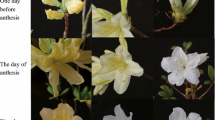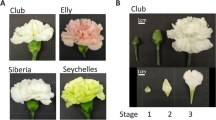Abstract
Petunia (Petunia hybrida) is an important ornamental plant, with corolla colors ranging widely from pink to red to purple, owing mainly to anthocyanins. Although there are no bright-yellow-flowered cultivars, some pale-yellow-flowered cultivars accumulate a small amount of carotenoids. To find a key regulatory step that controls carotenoid content in petunia corollas, we compared the expression of carotenoid metabolism genes and carotenoid composition in corollas of white-flowered and pale-yellow-flowered cultivars. Pale yellow corollas tended to have higher expression of biosynthesis genes. The most prominent result was the complete lack of carotenoid cleavage dioxygenase 4a (CCD4a) transcripts in pale yellow corollas. We found two insertions, one in the putative promoter region and the other in the coding region, of the genomic CCD4a sequence of a pale-yellow-flowered cultivar relative to that of a white-flowered cultivar. We consider this the main reason for the lack of CCD4a transcripts. The results suggest that pale yellow corollas have higher carotenoid biosynthesis activity and lower catabolism activity than white corollas. We propose that carotenoid content in petunia corollas is determined by the balance of the degradation and biosynthesis of carotenoids.







Similar content being viewed by others
Abbreviations
- CB:
-
Carpet Buttercream
- CCD1:
-
Carotenoid cleavage dioxygenase 1
- CCD4:
-
Carotenoid cleavage dioxygenase 4
- CG:
-
California Girl
- CHYB:
-
β-Ring hydroxylase
- CHYB/CYP97A:
-
Cytochrome P450-type β-ring hydroxylase
- CHYE/CYP97C:
-
Cytochrome P450-type ε-ring hydroxylase
- CRTISO:
-
Carotenoid isomerase
- CW:
-
Carpet White
- DXS:
-
1-Deoxy-d-xylulose 5-phosphate synthase
- EW:
-
Eagle White
- GGPS:
-
Geranylgeranyl pyrophosphate synthase
- IPI:
-
Isopentenyl diphosphate isomerase
- LCYB:
-
Lycopene β-ring cyclase
- LCYE:
-
Lycopene ε-ring cyclase
- MW:
-
Mambo White
- NCED:
-
9-cis-Epoxycarotenoid dioxygenase
- PDS:
-
Phytoene desaturase
- PS:
-
Prism Sunshine
- PSY:
-
Phytoene synthase
- RT-qPCR:
-
Reverse transcription quantitative real-time PCR
- ZDS:
-
ζ-Carotene desaturase
- ZEP:
-
Zeaxanthin epoxygenase
- Z-ISO:
-
15-cis-ζ-Carotene isomerase
References
Ariizumi T, Kishimoto S, Kakami R, Maoka T, Hirakawa H, Suzuki Y, Ozeki Y, Shirasawa K, Bernillon S, Okabe Y, Asamizu E, Rothan C, Ohmiya A, Ezura H (2014) Identification of the carotenoid modifying gene PALE YELLOW PETAL 1 as an essential factor in xanthophyll esterification and yellow flower pigmentation in tomato (Solanum lycopersicum). Plant J 79:453–465
Brazda V, Kolomaznik J, Lysek J, Haronikova L, Coufal J, Stastny J (2016) Palindrome analyser - a new web-based server for predicting and evaluating inverted repeats in nucleotide sequences. Biochem Biophys Res Commun 478:1739–1745
Britton G (1995) UV/visible spectrometry. In: Britton G, Liaaen-Jensen S, Pfander H (eds) Carotenoids, vol 1B. Birkhauser Verlag, Basel, pp 13–62
Brown MS, Goldstein JL (1993) Protein prenylation: mad bet for Rab. Nature 366:14–15
Camara B (1993) Plant phytoene synthase complex: component enzymes, immunology, and biogenesis. Methods Enzymol 214:352–365
Campbell R, Ducreux LJ, Morris WL, Morris JA, Suttle JC, Ramsay G, Bryan GJ, Hedley PE, Taylor MA (2010) The metabolic and developmental roles of carotenoid cleavage dioxygenase4 from potato. Plant Physiol 154:656–664
Cazzonelli CI, Pogson BJ (2010) Source to sink: regulation of carotenoid biosynthesis in plants. Trends Plant Sci 15:266–274
Falchi R, Vendramin E, Zanon L, Scalabrin S, Cipriani G, Verde I, Vizzotto G, Morgante M (2013) Three distinct mutational mechanisms acting on a single gene underpin the origin of yellow flesh in peach. Plant J 76:175–187
Felsenstein J (1997) An alternating least squares approach to inferring phylogenies from pairwise distances. Syst Biol 46:101–111
Fraser PD, Schuch W, Bramley PM (2000) Phytoene synthase from tomato (Lycopersicon esculentum) chloroplasts–partial purification and biochemical properties. Planta 211:361–369
Galpaz N, Ronen G, Khalfa Z, Zamir D, Hirschberg J (2006) A chromoplast-specific carotenoid biosynthesis pathway is revealed by cloning of the tomato white-flower locus. Plant Cell 18:1947–1960
Gonzalez-Jorge S, Ha SH, Magallanes-Lundback M, Gilliland LU, Zhou A, Lipka AE, Nguyen YN, Angelovici R, Lin H, Cepela J, Little H, Buell CR, Gore MA, Dellapenna D (2013) CAROTENOID CLEAVAGE DIOXYGENASE4 is a negative regulator of β-carotene content in Arabidopsis seeds. Plant Cell 25:4812–4826
Goodwin TW (1988) Carotenoids in higher plants. In: The biochemistry of the carotenoids vol 1 Plants. Chapman and Hall, London and New York, pp 143–188
Hai MTL, Masuda J, Miyajima I, Thien NQ, Mojtahedi N, Hiramatsu M, Kim J-H, Okubo H (2012) Involvement of carotenoid cleavage dioxygenase 4 gene in tepal color change in Lilium brownii var. colchesteri. J Japan Soc Hortic Sci 81:366–373
Hernandez-Garcia CM, Finer JJ (2014) Identification and validation of promoters and cis-acting regulatory elements. Plant Sci 217–218:109–119
Hirschberg J (2001) Carotenoid biosynthesis in flowering plants. Curr Opin Plant Biol 4:210–218
Ilg A, Yu Q, Schaub P, Beyer P, Al-Babili S (2010) Overexpression of the rice carotenoid cleavage dioxygenase 1 gene in golden rice endosperm suggests apocarotenoids as substrates in planta. Planta 232:691–699
Kishimoto S, Ohmiya A (2006) Regulation of carotenoid biosynthesis in petals and leaves of chrysanthemum (Chrysanthemum morifolium Ramat.). Physiol Plant 128:437–447
Kishimoto S, Maoka T, Nakayama M, Ohmiya A (2004) Carotenoid composition in petals of chrysanthemum (Dendranthema grandiflorum (Ramat.) Kitamura). Phytochemistry 65:2781–2787
Kishimoto S, Sumitomo K, Yagi M, Nakayama M, Ohmiya A (2007) Three routes to orange petal colour via carotenoid component in 9 Compositae species. J Japan Soc Hortic Sci 76:250–257
Liu Y-G, Whittier RF (1995) Thermal asymmetric interlaced PCR: automatable amplification and sequencing of insert end fragments from P1 and YAC clones for chromosome walking. Genomics 25:674–681
Liu H, Kishimoto S, Yamamizo C, Fukuta N, Ohmiya A (2013) Carotenoid accumulations and carotenogenic gene expressions in the petals of Eustoma grandiflorum. Plant Breed 132:417–422
Meier S, Tzfadia O, Vallabhaneni R, Gehring C, Wurtzel ET (2011) A transcriptional analysis of carotenoid, chlorophyll and plastidial isoprenoid biosynthesis genes during development and osmotic stress responses in Arabidopsis thaliana. BMC Syst Biol 5:77
Moehs CP, Tian L, Osteryoung KW, DellaPenna D (2001) Analysis of carotenoid biosynthetic gene expression during marigold petal development. Plant Mol Biol 45:281–293
Murakami Y, Fukui Y, Watanabe H, Kokubun H, Toya Y, Ando T (2003) Distribution of carotenoids in the flower of non-yellow commercial petunia. J Hortic Sci Biotechnol 78:127–130
Muszyński S (1964) A survey of anthocyanidins in Petunia. Physiol Plant 17:975–979
Nielsen KM, Bloor SJ (1997) Analysis and developmental profile of carotenoid pigments in petals of three yellow petunia cultivars. Sci Hortic 71:257–266
Ohmiya A (2009) Carotenoid cleavage dioxygenases and their apocarotenoid products in plants. Plant Biotechnol 26:351–358
Ohmiya A (2011) Diversity of carotenoid composition in flower petals. JARQ 45:163–171
Ohmiya A (2013) Qualitative and quantitative control of carotenoid accumulation in flower petals. Sci Hortic 163(2013):10–19
Ohmiya A, Kishimoto S, Aida R, Yoshioka S, Sumitomo K (2006) Carotenoid cleavage dioxygenase (CmCCD4a) contributes to white color formation in chrysanthemum petals. Plant Physiol 142:1193–1201
Okada K, Saito T, Nakagawa T, Kawamukai M, Kamiya Y (2000) Five geranylgeranyl diphosphate synthases expressed in different organs are localized into three subcellular compartments in Arabidopsis. Plant Physiol 122:1045–1056
Page RDM (1996) TREEVIEW: an application to display phylogenetic trees on personal computers. Comput Appl Biosci 12:357–358
Robert B, Horton P, Pascal AA, Ruban AV (2004) Insights into the molecular dynamics of plant light-harvesting proteins in vivo. Trends Plant Sci 9:385–390
Ruban AV, Berera R, Ilioaia C, van Stokkum IHM, Kennis ITM, Pascal AA, van Amerongen H, Robert B, Horton P, van Grondelle R (2007) Identification of a mechanism of photoprotective energy dissipation in higher plants. Nature 450:575–578
Rubio-Moraga A, Ahrazem O, Rambla JL, Granell A, Gómez-Gómez L (2013) Crocins with high levels of sugar conjugation contribute to the yellow colours of early-spring flowering crocus tepals. PLoS One 8:e71946
Santangelo TJ, Artsimovitch I (2011) Termination and antitermination: RNA polymerase runs a stop sign. Nat Rev Microbiol 9:319–329
Schwartz SH, Tan BC, Gage DA, Zeevaart JAD, McCarty DR (1997) Specific oxidative cleavage of carotenoids by VP14 of maize. Science 276:1872–1874
Simkin AJ, Schwartz SH, Auldridge M, Taylor MG, Klee HJ (2004a) The tomato carotenoid cleavage dioxygenase 1 genes contribute to the formation of the flavor volatiles β-ionone, pseudoionone, and geranylacetone. Plant J 40:882–892
Simkin AJ, Underwood BA, Auldridge M, Loucas HM, Shibuya K, Schmelz E, Clark DG, Klee HJ (2004b) Circadian regulation of the PhCCD1 carotenoid cleavage dioxygenase controls emission of β-ionone, a fragrance volatile of petunia flowers. Plant Physiol 136:3504–3514
Tornielli G, Koes R, Quattrocchio F (2008) The genetics of flower color. In: Gerats T, Strommer J (eds) Petunia: evolutionary, developmental and physiological genetics. Springer, New York, pp 325–342
Vitte C, Fustier M-A, Alix K, Tenaillon MI (2014) The bright side of transposons in crop evolution. Brief Funct Genomics 13:276–295
Yamagishi M, Kishimoto S, Nakayama M (2010) Carotenoid composition and changes in expression of carotenogenic genes in tepals of Asiatic hybrid lily. Plant Breed 129:100–107
Yamamizo C, Kishimoto S, Ohmiya A (2010) Carotenoid composition and carotenogenic gene expression during Ipomoea petal development. J Exp Bot 61:709–719
Yoshioka S, Aida R, Yamamizo C, Shibata M, Ohmiya A (2012) The carotenoid cleavage dioxygenase 4 (CmCCD4a) gene family encodes a key regulator of petal color mutation in chrysanthemum. Euphytica 184:377–387
Zhang B, Liu C, Wang Y, Yao X, Wang F, Wu J, King GJ, Liu K (2015) Disruption of a CAROTENOID CLEAVAGE DIOXYGENASE 4 gene converts flower colour from white to yellow in Brassica species. New Phytol 206:1513–1526
Funding
This work was supported by JSPS KAKENHI Grant Number JP25450051.
Author information
Authors and Affiliations
Corresponding author
Electronic Supplementary Material
Supplementary Fig. S1
Carotenoid analysis in corollas of petunia cultivars. Saponified carotenoid extracts from 0.4 g f.w. of limbs and tubes were analyzed by HPLC. Peaks: 1, (all-E)-neoxanthin; 2, (all-E)-violaxanthin; 3, (9′Z)-neoxanthin; 4, (9Z)-violaxanthin; 5, unknown carotenoid; 6, lutein; 7, antheraxanthin and zeaxanthin; 8, β-carotene. Designations of cultivars are as in Fig. 2. (PPTX 1449 kb)
Supplementary Fig. S2
Carotenoid analysis in leaves of CG and EW. Saponified carotenoid extracts from 0.4 g f.w. of leaves were analyzed by HPLC. Peaks: 2, (all-E)-violaxanthin; 3, (9′Z)-neoxanthin; 4, (9Z)-violaxanthin; 5, unknown carotenoid; 6, lutein; 7, antheraxanthin and zeaxanthin; 8, β-carotene. Designations of cultivars are as in Fig. 2. (PPTX 347 kb)
Supplementary Fig. S3
Alignment of deduced amino acid sequences of CCD1 and CCD4 of various plant species. AtCCD1, from Arabidopsis thaliana (acc. no. NM_116217); AtCCD4 (AtNCED4), A. thaliana (NM_118036); CcCCD4a, Citrus clementina (DQ309330); CcCCD4b, C. clementina (DQ309331); CmCCD4a, Chrysanthemum morifolium (AB247158); CmCCD4b, C. morifolium (AB247160); CsCCD4a, Crocus sativus (EU523662); CsCCD4b, C. sativus (EU523663); PhCCD1, Petunia hybrida (AY576003); PhCCD4a, P. hybrida (LC335775); PhCCD4b, P. hybrida (LC335772). Numbers at branch points indicate bootstrap values (1000 replicates). (PPTX 43 kb)
Supplementary Fig. S4
Genomic sequences of CCD4a presumed promoter and coding regions of California Girl (CG) and Eagle White (EW). Red arrows, genomic PCR primers for insertion detection; green arrows, primers for CCD4a RT-qPCR. Blue bar, insertion; pink bar, deletion in CG relative the sequence from EW. (PPTX 4613 kb)
ESM 1
(XLSX 27 kb)
Rights and permissions
About this article
Cite this article
Kishimoto, S., Oda-Yamamizo, C. & Ohmiya, A. Regulation of Carotenoid Pigmentation in Corollas of Petunia. Plant Mol Biol Rep 36, 632–642 (2018). https://doi.org/10.1007/s11105-018-1107-x
Published:
Issue Date:
DOI: https://doi.org/10.1007/s11105-018-1107-x




